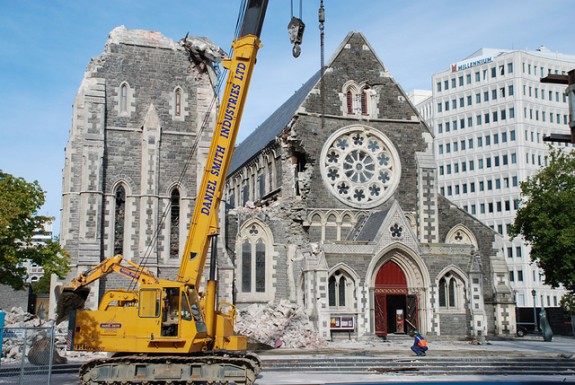New Zealand Is in the Midst of a Five-Month-Long Earthquake
It’s a magnitude 7 earthquake, and it’s been rocking New Zealand’s capital since January

Cleaning up damage from the 2011 Christchurch earthquake. Photo: Geof Wilson
Straddling the boundary between the Australian and Pacific tectonic plates, New Zealand is a land of earthquakes. In just the past few years, a series of devastating ones have hit near Christchurch, the country’s second-largest city, leveling large parts and killing hundreds of people. But for the past five* months an earthquake of a different kind, centered near Wellington, New Zealand’s capital city, has been slowly rocking the country.
It’s a magnitude 7 earthquake, and it’s been going on all year.
It’s the strongest earthquake to hit the region in 150 years says The New Zealand Herald, “but none of the locals are diving under desks or sheltering in doorways.”
In a normal earthquake, the Earth lurches, releasing in some cases multiple atomic bombs-worth of energy in seconds. The shaking and rolling felt at the surface makes buildings tumble and gas lines rupture—an unpredictable disaster that seems to strike out of nowhere.
But the Wellington earthquake is different. What’s happening near Wellington is that that same amount of energy, and the same amount of movement of the Earth’s surface, is being spread out over months and months. It’s still a magnitude 7 earthquake, it’s just a gradual one.
Wellington’s residents aren’t in a panic, says GeoNet, because the Wellington quake is a strange type of earthquake known as a “slow slip earthquake,” a style of tremblor that scientists only really discovered over the past decade.
Unlike earthquakes, which seem to occur almost at random, slow slip earthquakes can be recurrent. They come and go, sometimes happening annually. In New Zealand, the Wellington quake is actually the third of a set: similar earthquakes were detected in 2003 and 2008, says GeoNet.
Since we’ve been studying them for only a short while, scientists don’t know much about slow slip earthquakes. We know they happen in the same fault lines as big earthquakes, though usually much deeper in the Earth. We know they can be recurrent. And we’re starting to figure out what might be behind them. What we don’t really know, unfortunately, is how they’re related to the faster, more dangerous breed of earthquakes. But by studying them scientists hope we might be able to get a better grasp on the forces behind the killer quakes, and maybe one day let us predict the next Christchurch.
*Story corrected to reflect how many months we’ve actually had in 2013 so far
More from Smithsonian.com:
This Is Probably the World’s Most Beautiful Seismograph
Shattered: Christchurch After 10,000 Earthquakes
Seven Factors That Contribute to the Destructiveness of an Earthquake
/https://tf-cmsv2-smithsonianmag-media.s3.amazonaws.com/accounts/headshot/smartnews-colin-schultz-240.jpg)
/https://tf-cmsv2-smithsonianmag-media.s3.amazonaws.com/accounts/headshot/smartnews-colin-schultz-240.jpg)